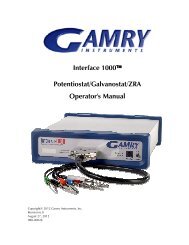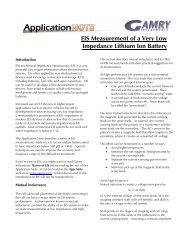Basics of Electrochemical Impedance Spectroscopy - Gamry ...
Basics of Electrochemical Impedance Spectroscopy - Gamry ...
Basics of Electrochemical Impedance Spectroscopy - Gamry ...
You also want an ePaper? Increase the reach of your titles
YUMPU automatically turns print PDFs into web optimized ePapers that Google loves.
Equivalent Element Admittance <strong>Impedance</strong><br />
R 1 R R<br />
C jω C 1 jω C<br />
L 1 jω L jω L<br />
W (infinite Warburg) Y 0 ( jω<br />
) 1 Y 0 ( jω<br />
)<br />
O (finite Warburg) Y 0 ( jω)<br />
Coth(<br />
B ( jω)<br />
)<br />
Table 3. Circuit Elements Used in the Models<br />
The dependent variables used in these equations are R,<br />
C, L, Y o , B, and α. The EIS300 uses these as fit<br />
parameters.<br />
Purely Capacitive Coating<br />
A metal covered with an undamaged coating generally<br />
has a very high impedance. The equivalent circuit for<br />
such a situation is in Figure 11.<br />
R C<br />
Figure 11. Purely Capacitive Coating<br />
The model includes a resistor (due primarily to the<br />
electrolyte) and the coating capacitance in series.<br />
Tanh(<br />
B ( jω)<br />
) Y 0 ( jω)<br />
Q (CPE) Y 0( j ω) α 1 Y 0( j ω) α<br />
A Nyquist Plot for this model is shown in figure 12. In<br />
making this plot, the following values were assigned:<br />
R = 500 Ω (a bit high but realistic for a poorly<br />
conductive solution)<br />
C = 200 pF (realistic for a 1 cm 2 sample, a 25 µm<br />
coating, and ε r = 6)<br />
F i = 0.1 Hz (lowest frequency is a bit higher than<br />
typical)<br />
F f = 1 MHz (highest frequency at the EIS300 limit)<br />
10<br />
( imag) i<br />
1 10 10<br />
8 10 9<br />
6 10 9<br />
4 10 9<br />
2 10 9<br />
0<br />
450 470 490 510 530 550<br />
real i<br />
Figure 12. Typical Nyquist Plot for an Excellent<br />
Coating<br />
The value <strong>of</strong> the capacitance cannot be determined<br />
from the Nyquist Plot. It can be determined by a curve<br />
fit or from an examination <strong>of</strong> the data points. Notice<br />
that the intercept <strong>of</strong> the curve with the real axis gives an<br />
estimate <strong>of</strong> the solution resistance.<br />
The highest impedance on this graph is close to 10 10 Ω.<br />
This is close to or above the limit <strong>of</strong> measurement<br />
capability <strong>of</strong> most EIS instruments.<br />
The same data are shown in a Bode Plot in Figure 13.<br />
Notice that the capacitance can be estimated from the<br />
graph but the solution resistance value does not appear<br />
on the chart. Even at 100 kHz, the impedance <strong>of</strong> the<br />
coating is higher than the solution resistance.




